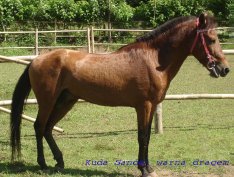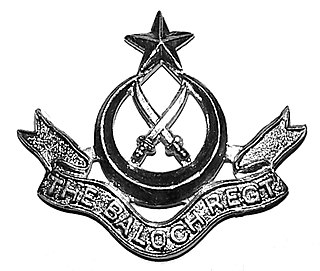Related Research Articles

Balochi is a Northwestern Iranian language spoken primarily in the Balochistan region of Pakistan, Iran and Afghanistan. In addition, there are speakers in Oman, the Arab states of the Persian Gulf, Turkmenistan, East Africa and in diaspora communities in other parts of the world. The total number of speakers, according to Ethnologue, is 8.8 million. Of these, 6.28 million are in Pakistan.

The Marwari or Malani is a rare breed of horse from the Marwar region of Rajasthan, in north-west India. It is closely related to the Kathiawari breed of the Kathiawar peninsula of Gujarat, with which it shares an unusual inward-curving shape of the ears. It is found in all equine colours, including piebald and skewbald. It is a hardy riding horse; it may exhibit a natural ambling gait.

The Kathiawari or Kathiawadi is an Indian breed of horse. It originates in the Kathiawar peninsula of Gujarat in western India, and is associated with the Kathi people of that area. It was originally bred as a desert war horse for use over long distances, in rough terrain, on minimal rations. It is closely related to the Marwari horses of Rajasthan; both breeds have been influenced by imported Arab horses. It is found in all colours except for black, and is most commonly chestnut. In the past it was used as a war horse and cavalry mount. Today it is used for riding, in harness and for sports; it may be used as a police horse and for the sport of tent-pegging. A stud-book is kept by the Kathiawari Horse Breeders' Association, which also organises annual shows.

The Kombai or Polygar dog is a breed of working dog native to Tamil Nadu in Southern India. Traditionally kept for guarding and protection, they have a reputation for making excellent guard dogs. They were also occasionally used for hunting big game.

The Gir or Gyr is an Indian breed of zebuine cattle. It originated in the Kathiawar peninsula in the state of Gujarat, and the name of the breed derives from that of the Gir Hills in that region. Other names include Bhodah, Desan, Gujarati, Kathiawari, Sorthi and Surti.

The Sandalwood Pony is a breed of small horse originating from Indonesia, on the Sumba and Sumbawa Islands. It is named after the Sandalwood trees, which are a major export of the country. The Sandalwood pony is one of the finest in the country, partly due to the great amount of Arabian blood. They make suitable children's ponies, and have been exported to Australia for this purpose. They have also been exported to other Southeast Asian countries for use as racing ponies.
Kathi may refer to:

Horse grooming is hygienic care given to a horse, or a process by which the horse's physical appearance is enhanced for horse shows or other types of competition.

The Baloch Regiment is an infantry regiment of the Pakistan Army. The modern regiment was formed in May 1956 by the merger of 8th Punjab and Bahawalpur Regiments with the Baluch Regiment. Since then, further raisings have brought the strength of the Regiment to 27 battalions. The Baloch Regiment is descended from the infantry of the old British Indian Army and is named after Balochistan. Before 1991, it was called the Baluch Regiment but the spelling was changed to 'Baloch' to better reflect the correct pronunciation.

The 129th Duke of Connaught's Own Baluchis was an infantry regiment of the British Indian Army raised in 1846 as the 2nd Bellochee Battalion. It was designated as the 129th Duke of Connaught's Own Baluchis in 1903, and became 4th Battalion 10th Baluch Regiment in 1922. In 1947, it was allocated to Pakistan Army, where it continues to exist as 11th Battalion of The Baloch Regiment.

Primitive markings are a group of hair coat markings and qualities seen in several equine species, including horses, donkeys, and asses. In horses, they are associated with primitive breeds, though not limited to such breeds. The markings are particularly associated with the dun coat color family. All dun horses possess at least the dorsal stripe, but the presence of the other primitive markings varies. Other common markings may include horizontal striping on the legs, transverse striping across the shoulders, and lighter guard hairs along the edges of a dark mane and tail.

The Dalmatian is a breed of dog, which has a white coat marked with black or brown-coloured spots. Originating as a hunting dog, it was also used as a carriage dog in its early days. The origins of this breed can be traced back to present-day Croatia and its historical region of Dalmatia. It is thought that early ancestors of the breed were certain breeds of pointers and a spotted Great Dane. Today, it is a popular pet and many enthusiasts enter Dalmatians into kennel club competitions.

The 10th Baluch or Baluch Regiment was a regiment of the British Indian Army from 1922 to 1947. After independence, it was transferred to the Pakistan Army. In 1956, it was amalgamated with the 8th Punjab and Bahawalpur Regiments. During more than a hundred years of military service, the 10th Baluch Regiment acquired a distinguished record amongst the regiments of the British Indian Army. Its list of honours and awards includes four Victoria Crosses.
The Baluchi is a domesticated breed of sheep originating from now southwest Pakistan, Baluchistan, eastern Iran and southern Afghanistan. It is a member of the fat-tailed breed. The Baluchi is raised primarily for wool.

The 130th King George's Own Baluchis (Jacob's Rifles) was an infantry regiment of the British Indian Army raised in June 1858 as the 1st Belooch Rifles; re-designated as 1st Regiment Jacob's Rifles in September. It was designated as 130th Jacob's Baluchis in 1903 becoming 5th Battalion (King George's Own) 10th Baluch Regiment (Jacob's Rifles) in 1922. In 1947, it was allotted to Pakistan Army, where it continues to exist as 12th Battalion of The Baloch Regiment.

The Auvergne horse is a breed of light draft horse from the Auvergne region of south central France. It stands 143 to 147 centimetres at the withers, and weighs 450–650 kilograms (990–1,430 lb). Coat colours are bay or seal brown. It is used mainly for trekking. It was recognised as a breed by the Haras Nationaux, the French association of horse breeders in December 2012. The standard is published by a breeders' association, the Association Nationale du Cheval de Race Auvergne.
Kathiawari or Kathiawadi may refer to:
References
- 1 2 "Baluchi". Oklahoma State University. Referenced 12/25/16.
- ↑ "TheHorseGuide.com". Archived from the original on 2010-12-25. Retrieved 2010-12-30.